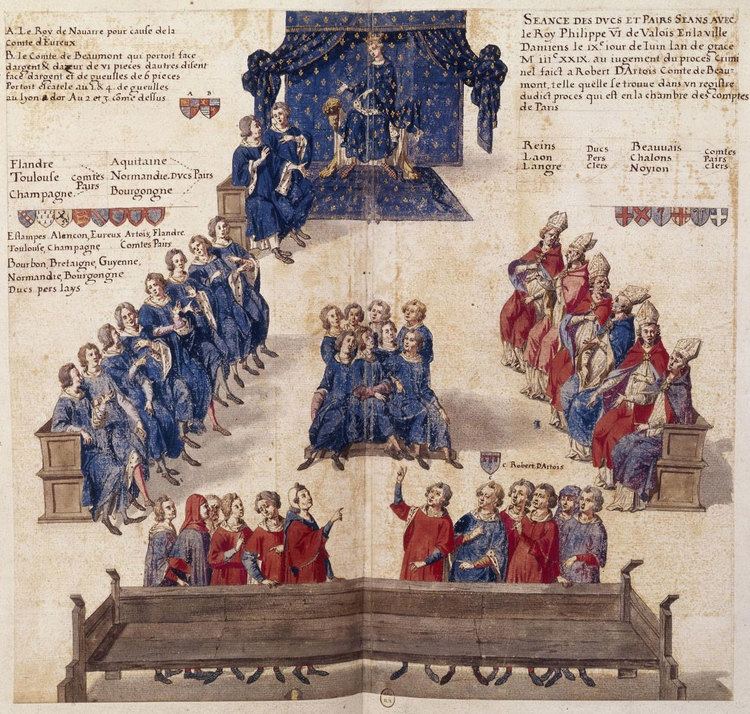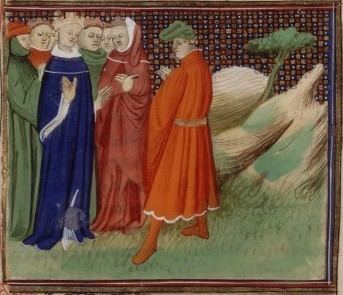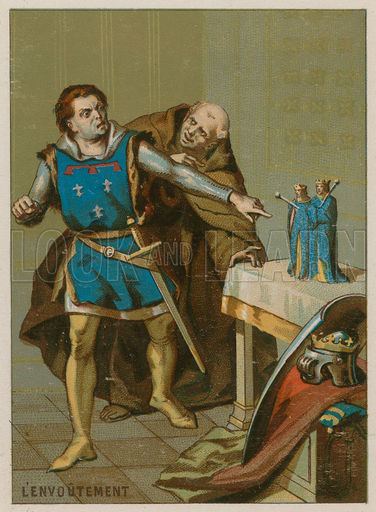Name Robert of | ||
 | ||
Children John of Artois, Count of Eu, Charles of Artois, Count of Pezenas Parents Philip of Artois, Blanche of Brittany Cousins Joan II, Countess of Burgundy, Blanche of Burgundy, Robert, Count of Burgundy | ||
Robert iii of artois
Robert III of Artois (1287–1342) was Lord of Conches-en-Ouche, of Domfront, and of Mehun-sur-Yèvre, and in 1309 he received as appanage the county of Beaumont-le-Roger in restitution for the County of Artois, which he claimed. He was also briefly Earl of Richmond in 1341 after the death of John III, Duke of Brittany.
Contents

Life

Robert was the son of Philip of Artois, Lord of Conches-en-Ouche, and Blanche of Brittany, daughter of Duke John II, Duke of Brittany, both descended in male line from the Capetian dynasty.

He was only eleven when his father died on 11 September 1298 from wounds he received at the Battle of Furnes on 20 August 1297 against the Flemish people. The early death of his father was an indirect cause of the dispute over the succession to the County of Artois. After the death of his grandfather, Robert II, Count of Artois, in the Battle of Courtrai in 1302, the latter's daughter, Mahaut, inherited the County of Artois in accordance with custom. Because of his age, Robert III could not object to his aunt and assert the rights which he inherited from his father. He would do so later. The rancor and intrigues between Mahaut (sometimes called Mathilde) and Robert occurred within a period of strife between France and England, before the Hundred Years' War.
Robert played an important role in the succession of Philip VI of France (his wife's half-brother) to the throne, and was his trusted adviser for some time. From this he drew a certain influence in the royal council which he used to try to wrest from Mahaut what he considered his county. At Mahaut's death in 1329, the claim passed to her daughter Joan II, Countess of Burgundy. Building on the example of the estate of the County of Flanders, he again raised the matter of succession. Artois was put under the custody of the King of France. However, in 1331, he used a forgery created by Jeanne de Divion attesting to the will of his father. This deception was discovered, and Robert lost any hope of acquiring Artois. The forger Divion was condemned at the stake. Robert's property was confiscated by Philip in 1331, and his wife and his sons John and Charles imprisoned. Robert fled France in 1332 to escape arrest and execution, and took refuge with his nephew John II, Marquis of Namur. Philip requested that the Bishop of Liège attack Namur. Accordingly, Robert fled again to John III, Duke of Brabant, his nephew-in-law. Again, the influence of Philip stirred up a war against Brabant, and Robert was exiled again, this time to England. There he joined Edward III and urged Edward–whose wife Philippa of Hainault also descended from Charles of Valois–to start a war to reclaim the Kingdom of France. While in England, he became a member of Edward's royal council and provided extensive information on the French court to the English king. Numerous contemporary chroniclers relate how Robert's influence led directly to the start of the Hundred Years War, specifically because Philip VI cited Edward's unwillingness to expel Robert as the reason for confiscating the Duchy of Aquitaine in May 1337. A vowing poem called the Voeux du héron (Vow of the Heron) circulated in France and England in the late 1340s that depicted Edward's invasion of France as the fulfilment of a chivalric oath made to Robert that he would take the French throne, as was his dynastic right.
Robert followed Edward in his campaigns thereafter, including command of the Anglo-Flemish army at the Battle of Saint-Omer in 1340. He ultimately succumbed to dysentery after being wounded while retreating from the city of Vannes in November 1342, during the War of the Breton Succession. He was originally buried in the Blackfriars church, in London, though his grave is now in St. Paul's Cathedral.
Family
Around 1320 Robert married Joan, daughter of Charles of Valois and his second wife Catherine I of Courtenay. They had six children:
In fiction
Robert III of Artois is a major character in Les Rois maudits (The Accursed Kings), a series of French historical novels by Maurice Druon in which many of these events are retold. He was played by Jean Piat in the 1972 French miniseries adaptation of the series, and by Philippe Torreton in the 2005 adaptation.
